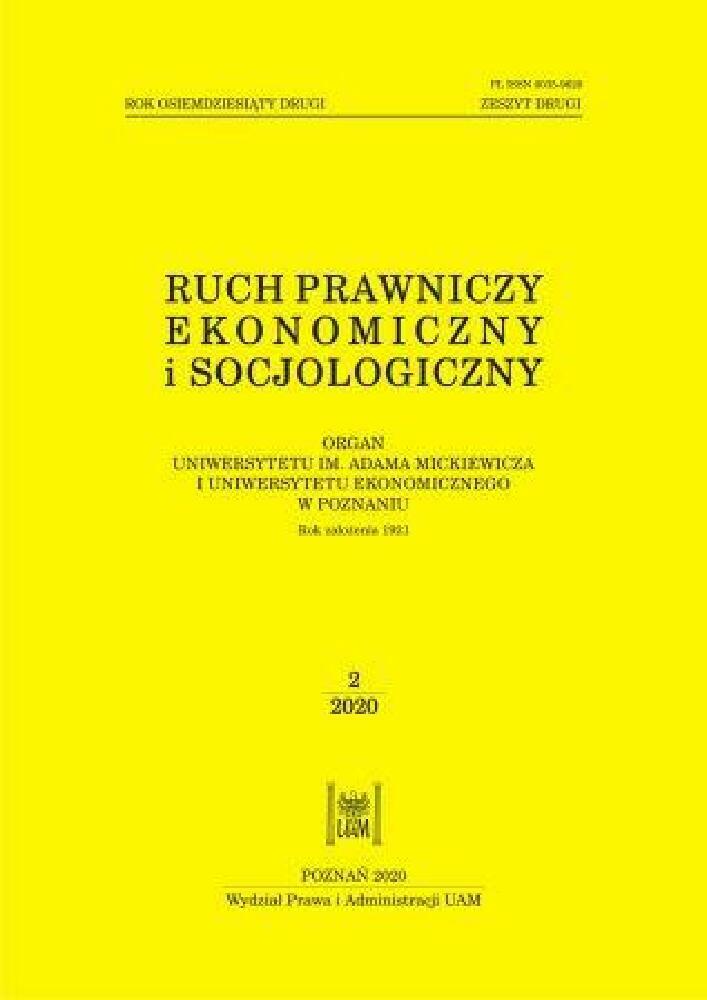Abstract
The importance of manufacturing in the economy nowadays depends on its international competitiveness and innovative activity, which allows the modernization of the material structure of production and improvement of the position in global value chains. The necessity to intensify efforts to improve the technological advancement of Polish manufacturing is an issue that regularly appears in the literature and business practice. The need to increase the capacity of Polish manufacturing to cope with global competition was also emphasized in the Strategia na rzecz Odpowiedzialnego Rozwoju (Strategy for Responsible Development) adopted by the Council of Ministers in 2017, in which the postulate of reindustrialization is one of the objectives. Bearing these conditions in mind, and the fact of regional diversity of the industrial potential in Poland, the aim of the article is to analyse the distribution of medium and high-tech manufacturing in the Polish economy. The study uses the method of critical literature analysis and statistical research. Based on a literature query, the idea of the territorialization of development and the role of manufacturing in the modern economy is presented. Regarding the diagnosis of the spatial distribution of manufacturing in Poland, the analysis of gross value added in the voivodeships system of division was used. The last part of the research focuses on the results of an empirical study which was carried out for the selected divisions of manufacturing in terms of changes in the number of entities and the level of employment. The results indicate an increase in the number of entities and a relatively constant employment level of technologically advanced divisions. The location quotient emphasizes the concentration of sold production of high- and medium-high-tech industries in the Dolnośląskie, Śląskie and Podkarpackie voivodeships.
References
Czyż, T. (2016). Metoda wskaźnikowa w geografii społeczno-ekonomicznej. Rozwój Regionalny i Polityka Regionalna 34: 9–19.
European Commission (2012). A Stronger European Industry for Growth and Economic Recovery. Industrial Policy Communication Update, COM (2012)582 final.
Głuszczuk, D. (2011). Istota rozwoju regionalnego i jego determinanty. Ekonomia 5(17): 68–80.
Gurbała, M. (2010). Przemysł high-tech a poziom rozwoju społeczno-gospodarczego krajów. Prace Komisji Geografii Przemysłu Polskiego Towarzystwa Geograficznego 16: 187–200.
GUS (2019a). Pojęcia stosowane w statystyce publicznej. <https://stat.gov.pl/metainformacje/slownik-pojec/pojecia-stosowane-w-statystyce-publicznej/773,pojecie.html> [dostęp: marzec 2019].
GUS (2019b). Bank Danych Lokalnych: Rachunki Regionalne. <https://bdl.stat.gov.pl/BDLS/dane/podgrup/temat> [dostęp: marzec 2019].
GUS (2019c). Statystyka regionalna. <https://stat.gov.pl/statystyka-regionalna/> [dostęp: marzec 2019].
GUS (2018). Rocznik statystyczny przemysłu. Warszawa.
Jewtuchowicz, A. (2005). Terytorium i dylematy jego rozwoju. Łódź: Wydawnictwo Uniwersytetu Łódzkiego.
Kaldor, N. (1967). Strategic Factors in Economic Development. Ithaca, NY: Cornell University Press.
Markowski, T. (2016). Kapitał terytorialny jako cel zintegrowanego planowania rozwoju. Mazowsze Studia Regionalne 18: 111–119.
Michalski, B. (2018). Looking for evidence of the middle-income trap. The case of Polish trade in high-tech goods with Germany. Post-Communist Economies 30(3): 405–420.
Kwaśny, J., Mroczek, A., Ulbrych, M. (2018). Industrial clustering and economic performance: in search for evidence from Poland. Economic and Managerial Spectrum 13(1): 109–119.
Ministerstwo Rozwoju (2017). Strategii na rzecz Odpowiedzialnego Rozwoju do roku 2020 (z perspektywą do 2030 r.) Warszawa.
Murzyn, D. (2019). Rozwój przemysłu poprzez inteligentne specjalizacje i instrumenty polityki regionalnej UE w województwie małopolskim. Prace Komisji Geografii Przemysłu Polskiego Towarzystwa Geograficznego 33(1): 130–142.
Nowakowska, A. (2017). Terytorializacja rozwoju i polityki regionalnej. Biuletyn KPZK PAN 268: 26–38.
Nowakowska, A., Walczak, B. (2016). Dziedzictwo przemysłowe jako kapitał terytorialny. Przykład Łodzi. Gospodarka w Teorii i Praktyce 45: 45–56.
OECD (2001). OECD Territorial Outlook. OECD Publications Service. Smętkowski, M. (2011). Polityka spójności a konkurencyjność dużych polskich miast. Studia Regionalne i Lokalne (wydanie specjalne): 31–56.
Stehrer, R., Stöllinger, R. (2015). The Central european manufacturing core: what is driving regional production sharing?, FIW Research Reports, No. 2014/15-02.
Stöllinger, R., Foster-McGregor, N., Holzner, M., Landesmann, M., Pöschl, J., Stehrer, R. (2013). A Manufacturing Imperative in the EU – Europe’s Position in Global Manufacturing and the Role of Industrial Policy. Wiener Institut für Internationale Wirtschaftsvergleiche Research Report 391.
Stryjakiewicz, T. (1999). Adaptacja przestrzenna przemysłu w Polsce w warunkach transformacji. Poznań.
Ulbrych, M. (2014). Znaczenie przemysłu w gospodarce i polityce regionalnej Unii Europejskiej. Prace Komisji Geografii Przemysłu Polskiego Towarzystwa Geograficznego 26: 31–45.
Ulbrych, M. (2016a). Indeks partycypacji polskiego przetwórstwa przemysłowego w globalnych łańcuchach wartości. Prace Komisji Geografii Przemysłu Polskiego Towarzystwa Geograficznego 30(3): 59–74.
Ulbrych, M. (2016b). Serwicyzacja produkcji przemysłowej. Wnioski dla Polski. Finanse, Rynki Finansowe, Ubezpieczenia 3(81): 253–264.
UNIDO, Classification of manufacturing sectors by technological intensity (ISIC Revision 4), <http://stat.unido.org/content/focus/classification-of-manufacturing-sectors-by-technological-intensity-%2528isic-revision-4%2529;jsessionid=4DB1A3A5812144CACC956F4B8137C-1CF> [dostęp: marzec 2019].
Zakrzewska-Bielawska, A. (2011). Relacje między strategią a strukturą organizacyjną w przedsiębiorstwach sektora wysokich technologii. Zeszyty Naukowe Politechniki Łódzkiej 1095.
Zioło, Z. (2001). Współczesne tendencje rozwoju przemysłu i ich problematyka badawcza. Prace Komisji Geografii Przemysłu 2: 9–19.
License
Copyright (c) 2020 WPiA UAM

This work is licensed under a Creative Commons Attribution-NonCommercial-NoDerivatives 4.0 International License.





